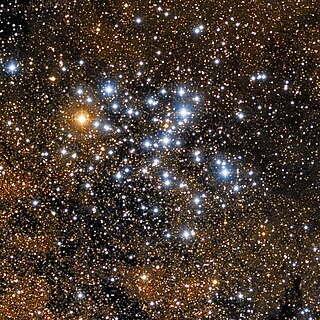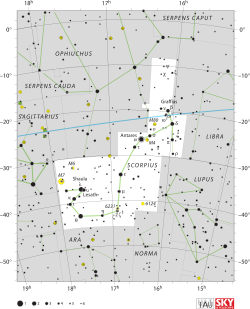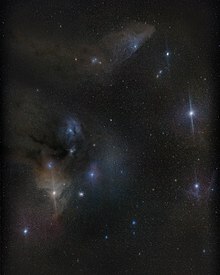
Antares is the brightest star in the constellation of Scorpius. It has the Bayer designation α Scorpii, which is Latinised to Alpha Scorpii. Often referred to as "the heart of the scorpion", Antares is flanked by σ Scorpii and τ Scorpii near the center of the constellation. Distinctly reddish when viewed with the naked eye, Antares is a slow irregular variable star that ranges in brightness from an apparent visual magnitude of +0.6 down to +1.6. It is on average the fifteenth-brightest star in the night sky. Antares is the brightest and most evolved stellar member of the Scorpius–Centaurus association, the nearest OB association to the Sun. It is located about 170 parsecs (550 ly) from Earth at the rim of the Upper Scorpius subgroup, and is illuminating the Rho Ophiuchi cloud complex in its foreground.

Centaurus is a bright constellation in the southern sky. One of the largest constellations, Centaurus was included among the 48 constellations listed by the 2nd-century astronomer Ptolemy, and it remains one of the 88 modern constellations. In Greek mythology, Centaurus represents a centaur; a creature that is half human, half horse. Notable stars include Alpha Centauri, the nearest star system to the Solar System, its neighbour in the sky Beta Centauri, and V766 Centauri, one of the largest stars yet discovered. The constellation also contains Omega Centauri, the brightest globular cluster as visible from Earth and the largest identified in the Milky Way, possibly a remnant of a dwarf galaxy.

Libra is a constellation of the zodiac and is located in the Southern celestial hemisphere. Its name is Latin for weighing scales. Its old astronomical symbol is (♎︎). It is fairly faint, with no first magnitude stars, and lies between Virgo to the west and Scorpius to the east. Beta Librae, also known as Zubeneschamali, is the brightest star in the constellation. Three star systems are known to have planets.

Lupus is a constellation of the mid-Southern Sky. Its name is Latin for wolf. Lupus was one of the 48 constellations listed by the 2nd-century astronomer Ptolemy, and it remains one of the 88 modern constellations but was long an asterism associated with the just westerly, larger constellation Centaurus.

Sagittarius is one of the constellations of the zodiac and is located in the Southern celestial hemisphere. It is one of the 48 constellations listed by the 2nd-century astronomer Ptolemy and remains one of the 88 modern constellations. Its old astronomical symbol is (♐︎). Its name is Latin for "archer". Sagittarius is commonly represented as a centaur drawing a bow. It lies between Scorpius and Ophiuchus to the west and Capricornus and Microscopium to the east.

Messier 7 or M7, also designated NGC 6475 and sometimes known as the Ptolemy Cluster, is an open cluster of stars in the constellation of Scorpius. The cluster is easily detectable with the naked eye, close to the "stinger" of Scorpius. With a declination of −34.8°, it is the southernmost Messier object.

The Butterfly Cluster is an open cluster of stars in the southern constellation of Scorpius. Its name derives from the vague resemblance of its shape to a butterfly. The Trumpler classification of II 3 r encodes it is rich in stars, ranks II out of IV for disparateness and greatly mixes bright with faint components. It is 3.5° to the northwest of Messier 7, both north of the tail of Scorpius.

An asterism is an observed pattern or group of stars in the sky. Asterisms can be any identified pattern or group of stars, and therefore are a more general concept than the 88 formally defined constellations. Constellations are based on asterisms, but unlike asterisms, constellations outline and today completely divide the sky and all its celestial objects into regions around their central asterisms. For example, the asterism known as the Big Dipper comprises the seven brightest stars in the constellation Ursa Major. Another is the asterism of the Southern Cross, within the constellation of Crux.

Delta Scorpii is a binary star in the constellation of Scorpius. The primary star is named Dschubba.

Kappa Scorpii, Latinized from κ Scorpii, is a binary star system in the southern constellation of Scorpius. With an apparent visual magnitude of 2.4, this star system is readily visible to the naked eye. Parallax measurements place it at an estimated distance of roughly 480 light-years from the Earth.

Upsilon Scorpii, formally named Lesath, is a star located in the "stinger" of the southern zodiac constellation of Scorpius, the scorpion. Based on parallax measurements obtained during the Hipparcos mission, it is approximately 580 light-years from the Sun. In the night sky it lies near the 1.6 magnitude star Lambda Scorpii, and the two form an optical pair that is sometimes called the "Cat's Eyes".

Sigma Scorpii, is a multiple star system in the constellation of Scorpius, located near the red supergiant Antares, which outshines it. This system has a combined apparent visual magnitude of +2.88, making it one of the brighter members of the constellation. Based upon parallax measurements made during the Hipparcos mission, the distance to Sigma Scorpii is roughly 696 light-years (214 parsecs). North et al. (2007) computed a more accurate estimate of 568+75
−59 light years.

Scorpio (♏︎) is the eighth astrological sign in the zodiac, originating from the constellation of Scorpius. It spans 210–240° ecliptic longitude. Under the tropical zodiac, the Sun transits this sign on average from October 23 to November 21. Depending on which zodiac system one uses, someone born under the influence of Scorpio may be called a Scorpio or a Scorpionic.

Tau Scorpii, Latinized from τ Scorpii, formally known as Paikauhale, is a star in the southern zodiac constellation of Scorpius. The apparent visual magnitude of Tau Scorpii is +2.8, while parallax measurements yield a distance estimate of roughly 470 light-years (150 parsecs) from Earth.
Omicron Scorpii is a star in the zodiac constellation of Scorpius. With an apparent visual magnitude of +4.57, it is visible to the naked eye. Parallax measurements indicate a distance of roughly 900 light years. It is located in the proximity of the Rho Ophiuchi dark cloud.

Mu2 Scorpii (μ2 Scorpii, abbreviated Mu2 Sco, μ2 Sco), also named Pipirima, is a star in the zodiac constellation of Scorpius. It has an apparent visual magnitude of +3.56, which is bright enough to be seen with the naked eye. Its distance from the Sun is about 474 light-years, as determined by parallax measurements. It is a member of the Upper Centaurus–Lupus subgroup of the Scorpius–Centaurus association.

Mu1 Scorpii (μ1 Scorpii, abbreviated Mu1 Sco, μ1 Sco) is a binary star system in the southern zodiac constellation of Scorpius. The combined apparent visual magnitude of the pair is about magnitude 3, making it one of the brighter members of Scorpius. Based upon parallax measurements, the distance of this system from the Sun is roughly 500 light-years (150 parsecs). This system is a member of the Scorpius–Centaurus association, the nearest OB association of co-moving stars to the Sun.

NGC 6231 is an open cluster in the southern sky located half a degrees north of Zeta Scorpii. NGC 6231 is part of a swath of young, bluish stars in the constellation Scorpius known as the Scorpius OB1 association. The star Zeta1 is a member of this association, while its brighter apparent partner, Zeta2, is only 150 ly from Earth and so is not a member.
This table lists those stars or other objects which have Bayer designations, grouped by the constellation part of the designation.

![]() (♏︎).[ citation needed ]
(♏︎).[ citation needed ]














